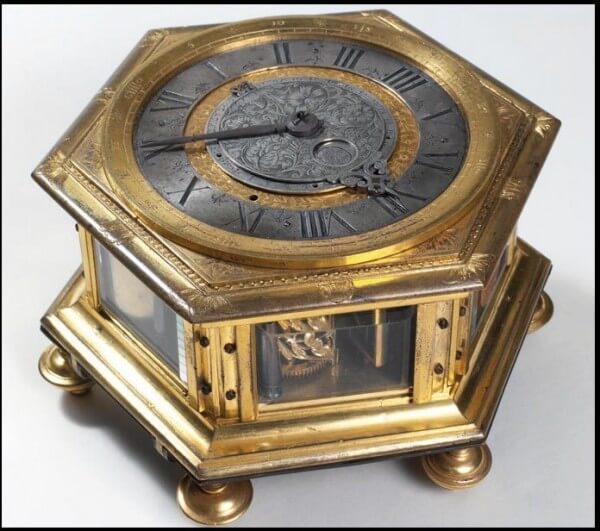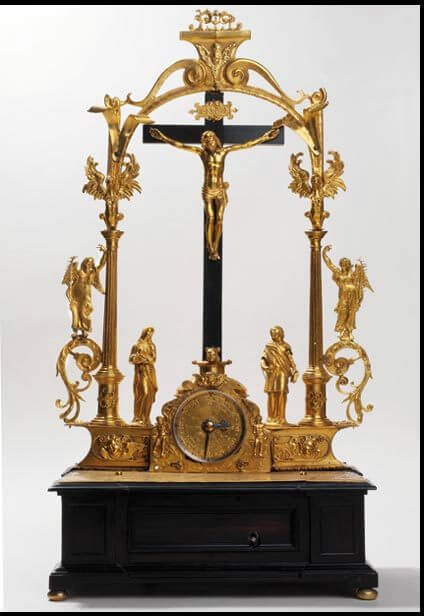Fine Watchmaking is a modern-day concept, used to distinguish mechanisms whose technical prowess is matched by the skill of artisans. Or is it? The exhibition at the Museum of Fine Arts in Arras reminds us that the origins of fine watchmaking reach back to the very early history of the branch. Under the title, The inventors of time – Treasures of horology from 1500 to 1700,* this exhibition gives pride of place to Renaissance pieces, the culmination of a mechanical concept of time measurement which opened up new avenues of research and exploration. “Drawing on every science – mechanics, astronomy, physics and mathematics – and every art – miniature painting, engraving, enamelling, cabinet-making, goldsmithing and stone-setting – horology set out in pursuit of technological and artistic excellence,” observes the watchmaker and restorer Bernard Sénéca, scientific commissioner for the exhibition and author of the catalogue.**
Useful, calendar and astronomical functions
Throughout these two hundred years, horology became a profession in its own right, asserting itself in the main European centres of Blois, Lyons, Rouen, Strasbourg, London, Geneva and the Netherlands. That watchmakers were able to come together as a corporation was first and foremost thanks to advances that opened up a genuine market for their wares. Towards 1500, the notion of the mechanical measurement of time culminated in the invention of the watch. Over the next two centuries, master watchmakers and scholars would pit their knowledge as they sought ingenious ways to endow these instruments with the ability to accurately measure time. Several pieces illustrate this, such as a hexagonal table clock (signed MC, Germany, circa 1640). This piece is outstanding for its minute hand, a rare feature at that time, and for its remontoire which ensured a constant transmission of power to the movement. This pursuit of accuracy drew nearer its goal with the invention of the pendulum clock (1657) and the balance spring (1674) by the Dutch mathematician, Huygens.

As clocks, watches and oignons (bulbous onion-shaped watches) trickled down into more levels of society, closer attention was paid to their functions. The first were practical, such as giving the hour, more rarely the minutes and, in exceptional cases, the seconds (two clocks made by Thuret for Christiaan Huygens). Other useful functions were a passing strike (and towards the late seventeenth century, striking on demand), an alarm and à tact watches where time was ascertained by touch, thus doing away with the need to “strike a light.” They were joined by calendar and astronomical functions, particularly after the introduction of the Gregorian calendar (in France, for example, by royal decree in 1582). Table clocks and astrolabes demonstrated the extent of knowledge at that time. As instruments of scientific research, they would play an important role in diffusing notions of astronomy such as moon phases, the positions of the planets, the equation of time and positions of the zodiac. Often, these functions were combined with calendar indications (months and days) and possibly mythological symbols. Note that many of these timepieces can be considered forerunners to today’s grandes complications watches, as they combined useful, calendar and astronomical functions. Naturally, these exceptional pieces were reserved for a wealthy clientele, many of whom were recruited in the entourage of royal courts.
Decorative splendour
This, however, was far from the full extent of progress in horology at that time. In addition to incorporating these feats of technicality, timepieces became blank canvases for elaborate and skilled decoration. Renaissance timepieces were richly embellished by miniature painters, engravers, cabinet-makers, goldsmiths and enamellers. This complex table clock (circa 1600) is one example. An automaton, in the form of a cross, represents the relentless passing of time. A crowned lion (Gaspard Pfaff, circa 1630) in molten brass springs to life when this clock strikes. The gold filigree case of this watch by Jean Paris (circa 1660) has been set with cut diamonds, a then innovative technique. And so the masters of fine arts turned their attention to the decoration of time, whether the exterior of a timepiece or the movement itself, whose upper side was often engraved. Enamelling developed into an art in its own right, as timepieces were embellished with champlevé, pea-pod decors and painted miniatures. This latter art was perfected by Jean Toutin and would be perpetuated by his two sons. It would reach its apogee with the Huaud family who interpreted works by the great masters Rembrandt, Raphael, Perugino and Leonardo da Vinci in painstaking enamel.

These artists and craftsmen performed wonders. They conferred upon mechanical timekeeping a dimension that would continue until today, when we still strive to show ourselves worthy of our ancestors. “Thanks to the talent of these artisans, we know of no other mechanical work which, three centuries after its making, in addition to the beauty of its decoration, continues to function and to provide us with a perfectly acceptable measurement of time in our contemporary world,” notes Bernard Sénéca. “Over the course of two tumultuous centuries, from François I, the Roi Chevalier, to Louis XIV, the Roi Soleil, these men conceived, with precious little means, masterpieces that profoundly changed their contemporaries’ way of life.” Today’s Fine Watchmaking is, without doubt, their direct descendent.
*Les inventeurs du temps – Trésors de la haute époque horlogère (1500 – 1700) Arras, Musée des Beaux-Arts, February 7 – April 28, 2009.
**[Les inventeurs du temps – by Bernard Sénéca
Published by Degeorge, 2009 – 176 pages.
















